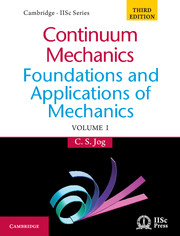2 - Kinematics
Published online by Cambridge University Press: 05 August 2015
Summary
Under the continuum hypothesis, the material being studied, irrespective of whether it is solid, liquid or gas, is assumed to be continuous. In reality, any matter is composed of a large number of discrete atoms or molecules. However, continuum mechanics ignores this discontinuous structure, and treats matter as if it is continuous. This hypothetical continuous material is called a continuum. The concept of a continuous medium permits us to define quantities such as density, momentum, energy, etc. at each point in the domain occupied by the material. Since these quantities are assumed to have a continuous distribution in space, we can use all the machinery of calculus, including the concepts of derivatives and integrals, to formulate the governing equations. It has been found that the theories of elasticity, fluid mechanics, etc. based on a continuum model yield to quantitative predictions that agree closely with experience. This is perhaps the best justification for using the continuum hypothesis.
The continuum hypothesis is violated when the mean distance that atoms or molecules move between collisions is of the same order of magnitude as the characteristic length scale of the flow, a situation that occurs in low-density or rarefied flow. Such low-density flows occur only in very special situations such as, for example, flow around an airplane at a very high altitude. We do not consider such special situations in this book.
Although we have said that the continuum hypothesis ignores the molecular structure of matter, it does have to account for the fact that rubber and steel, say, behave very differently under the same loading conditions. This is done by means of constitutive equations, which we shall discuss in Chapter 4.
Kinematics refers to the results that can be obtained about the nature of a continuum without reference to the dynamics of the continuum. Thus, kinematics refers to those results that can be obtained purely from geometrical considerations, without reference to the forces acting on the continuum. These results are subsequently used in formulating the balance laws in Chapter 3.
- Type
- Chapter
- Information
- Continuum MechanicsFoundations and Applications of Mechanics, pp. 137 - 165Publisher: Cambridge University PressPrint publication year: 2015



